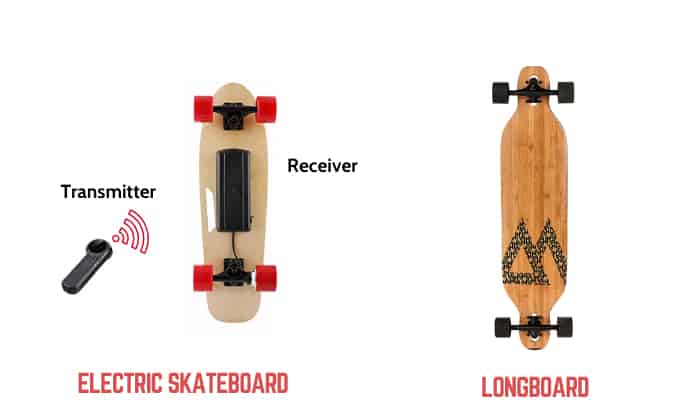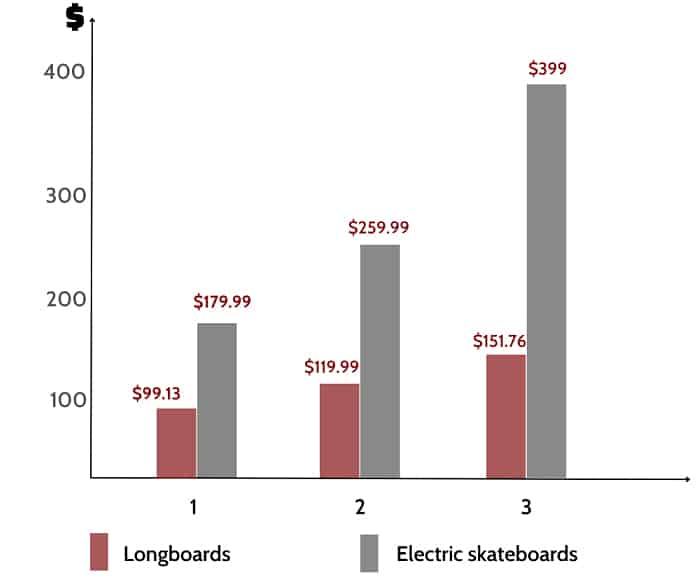Electric skateboards are popular for their speed, power, and impeccable thrill. These features make them ideal for long, fast rides or simple commutes. But like e-skates, longboards are also suitable for these purposes.
Now, electric skateboard VS longboard, what is the better board to ride? How is one different from the other in overall performance? And which of these boards can provide the thrill we want?
This article will answer all these questions. We’ll learn more about these recreational boards and see how they benefit us.
Table of Contents
Electric Skateboards and Longboards: Defined
Spotting a difference between longboard and skateboard with electronics is straightforward. But first, you should learn the basics about them.
1. Electric skateboards
From their very name, e-skateboards have electronic components making them fast, powerful, and thrilling.
These skateboards feature batteries, motors, and remote devices as their primary control source. In performance, skaters who use this board type are freed from exerting effort pushing and braking, since these functions are accessible through the handy controller.
E-skateboards might vary in design. And such variations often indicate where they do best, whether on the city streets or off-road.
2. Longboards
Longboards can also be thrilling and fast. If you have a longboard compared to skateboard of regular kinds, this type has a more extended and spacious stepping surface.
Longboards have their primary components in the deck, trucks, and wheels. But of course, like the deck, all other parts vary in size and other aspects.
Where do we use longboards? The most popular longboard usage is downhill skating. The others are cruising and casual commuting.
Differences Between Electric Skateboards and Longboards
We now know a few aspects of e-skateboards and longboards. Let’s see how they differ in the following areas.
Shape
Generally, variations in skateboard and longboard shapes aim to suit specific riding styles and skater groups.
Electric shortboard and longboard shapes come in two styles: directional and symmetrical. Symmetrical e-skateboard decks allow the skater to ride the board without consideration of the nose or tail. Both ends are equal.
Meanwhile, directional shapes find the nose and tail in different shapes, thus requiring the rider to identify which end to put forward.
How About Longboards?
Longboards have more shape varieties. Mainly, these shapes are also directional and symmetrical. But more specifically, these skateboard cuts include pintail, drop-down, cruiser, and more.
1. Trucks
The trucks hold the entire wheel system of the longboard. Generally, there are two types used in this board type: standard and reverse kingpin. However, the latter is the most commonly used. RKP trucks are more versatile (fitting both top-mount and drop-through decks) and allow users to balance themselves more easily.
Perhaps, electric skateboard trucks vary more. Aside from the previous two types, e-boards also have chamber trucks with distinctive bushing wedges.
2. Wheels
The wheels are indicative of a smooth or sluggish ride.
For longboards, wheels have sizes ranging from 60mm to 107mm. The larger the wheel diameter gets, the faster it is but slower to accelerate.
Besides size, hardness is also a significant aspect of longboard wheels. By range, the softest longboard rollers come at 73a, with the hardest at 101a. The softer the wheel is, the more grip it has. Softer longboard wheels fit rough surfaces more.
If longboard wheel makers use polyurethane mainly, electric skateboard brands add pneumatic types to their array. You probably already know about urethane wheels. So, what is a pneumatic roller?
If you have noticed, these wheels have exceptional sizes. Often, they stand taller than the deck’s height. Pneumatic e-skateboard wheels have an air tube inside, like a bicycle wheel. Some of the benefits we get from this roller type are increased traction and fewer shocks.
Pros and Cons
Let’s highlight the discussed and inherent advantages and limitations of e-skateboards and longboards.
Electric skateboard
- Fast and powerful
- Easy to operate with remote control
- Limited battery life
- Challenging to maintain and repair
- Costly
Longboard
- Ideal for beginners
- Soft wheels dodge road cracks and debris easily
- Bulkier than other board types
- More effort to operate than e-skateboards
Electric Skateboard and Longboard Prices
They say longboards are more costly than regular skateboards. Similarly, e-skateboards are pricey by nature. So, we might as well prepare enough money before buying either of them.
Longboards
- APOLLO Longboard – $99.13
- Magneto Bamboo Carbon Fiber Longboard – $119.99
- Atom All-Terrain Longboard – $151.76
Electric skateboards
- Teamgee H3 DIY Electric Skateboard – $259.99
- SIFLIF Electric Skateboard with Wireless Remote – $179.99
- Blitzart 38″ Dual Motor Electric Longboard Skateboard – $399.00
Related: Normal skateboard vs electric skateboard.
Which is Better?
Is a longboard better than a skateboard with batteries and motors?
Indeed, electric skateboards and longboards have their share of uniqueness and desirable features. But overall, which is the better board to use?
Since both board types are advantageous in at least one aspect, we should decide based on priority.
Electric skateboards have the upper hand in fast and convenient rides because of their electronic components. But despite longboards not having these, they are less prone to breakage should they get ridden under wet weather.
If you don’t mind pushing now and then, a longboard will be fine. However, you won’t have to do this on an electric skateboard.
Frequently Asked Questions
How long do longboards last?
Durability isn’t a negligible aspect, whether on electric or non-electric boards. So, how long can a longboard last?
On average, longboards live for two months, the shortest, to 5 months at most. But such numbers could change based on several factors. One is the skater’s degree of usage. And another is how you take care of your longboard.
Also, note that the timeline might vary on a per-part basis. Your trucks might wear out more slowly than the deck or your wheels.
Penny board VS long board VS shortboard skateboard
How is a longboard different from a penny board or shortboard? Let’s consider the following points.
- Size – Longboards are the longest at around 33 to 59 inches. Penny boards are 22″ to 36″, and shortboards go about 28 – 32 inches.
- Deck shape – Longboards have more shape variations in pintails, drop-through, and kick tails. This flexibility isn’t available with penny boards. As for a longboard VS shortboard skateboard, the latter has pointed ends, contrary to a longboard’s rounded ends.
- Purpose – The differences between the three boards aren’t without reasons. Longboards are for comfortable and more stable cruising rides. Penny boards, essentially, are for skaters who are on a budget and are not suitable for challenging terrains or long distances.
Ultimately, shortboards provide the best speed and maneuverability.
Conclusion
Technology is pivotal in the growth of skating. We have witnessed the emergence of electric skateboards and observed how they differ from conventional boards. What’s good about these discoveries is that they are all for the better.
Electric skateboard VS longboard: which is better? Both board types are functional and relevant. E-skateboards might be faster and more powerful, but longboards could be lighter. E-skates could have their electronic parts damaged, but longboards never encounter such issues.
Moving forward, it’s our preference that matters the most. All we should do is check each board to decide which one to use.

Hi, I am Charles Harris. I opened this site to write as much as I can about my biggest passion – skateboarding!
I started as a clumsy yet passionate rookie 10 years ago to now a still passionate yet much better skateboarder! But I have to tell you, the whole journey has always been fun and rewarding, indeed not without hardship.











